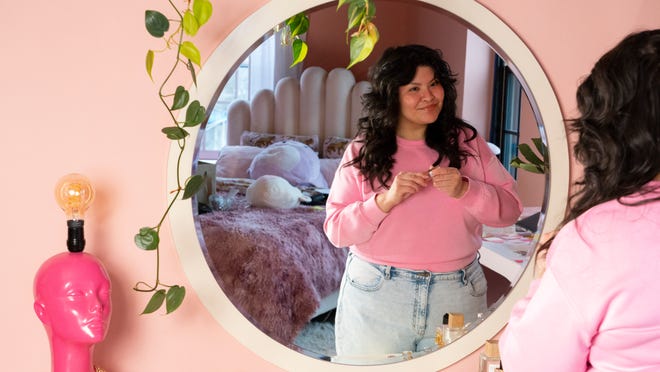
When 28-year-old Kelly Marcelo moved into her downtown Indianapolis apartment in early 2022, she faced an uncertain future.
Formerly a wedding photographer, she had decided to transition away from that career just before the pandemic, and she still felt a little lost.
“I really threw myself into my home décor as a way to kind of create my own world,” she said, “where no matter what was going on outside, no matter what else happened, I would have this little space here that made me happy.”
Marcelo has curated a style she describes as hyper-feminine, “refined maximalism.” Maximalist design often includes bright, bold colors, abstract shapes, wallpaper and patterned and textured textiles. In Marcelo’s case, that often means soft pink, abstract furniture and mirrors, and statement pieces like a mannequin head painted bright pink and upcycled into a lamp. She began sharing her finds, many of which have come from thrift stores and Facebook Marketplace, on social media.
And her style resonated. Since she began posting her content to TikTok in February 2022, Marcelo has amassed a combined social media following of nearly 140,000, and has garnered brand partnerships with 3M, Home Depot, Pinterest and Sherwin-Williams. She was also among volunteers selected to help decorate the White House last Christmas.
Her goal for the content she creates, from thrift finds to organizing file folders: “Make everything fun.”
What is maximalism?
Maximalism is a design style that’s been creeping into the mainstream home and design show circuit in recent years, said Nina Klemm, a Carmel-based designer and former Bravo TV personality. It’s a stark difference, she said, from the farmhouse style prominent in home design in recent years that leans into a neutral color palette, often using varying shades of gray, white and beige.
Put it simply, Klemm said, it’s about “embracing boldness, (and) eliminating fear.”
Maximalist design can include bright, bold colors, wallpaper, textured and patterned furniture and textiles, as well as playful takes on lamps, curved mirrors, abstract artwork, and, as seen in the 2021 HGTV Urban Oasis home in Broad Ripple, even a 40-inch disco ball over the dining table.

The walls and ceiling in the home’s living room were painted mustard yellow, for example, contrasting with the bright white painted brick fireplace. Custom gold and flax-colored drapery in the living room added texture and pattern. One room over, in the kitchen and dining area, walls and ceiling were a soft pink, with oversized copper light fixtures and the aforementioned disco ball.
The home’s designer, Brian Patrick Flynn, told IndyStar at the time that he was aiming to capture the neighborhood’s “super carefree, happy, supportive vibe,” balancing complex color schemes with neutral flooring and cabinetry.
Maximalist design has to be constructed intentionally, Klemm said.
“I think that a lot of people can look at it and get overwhelmed, because there is a fine line between the chaos and the balance,” she said. “It can be done in layers, and as long as you keep it consistent and cohesive, then you can just build upon that over time.”
Maximalist home design basics
Klemm, who got her start in fashion and then moved to real estate and interior design, describes her style as modern maximalism with a touch of glam — bold colors, playful shapes, lots of texture and shine.
The key to building a cohesive design that doesn’t become overwhelming, she said, is to start with a concept and a color scheme.
Is there a focal point, such as a piece of artwork or furniture, to which you want to draw attention? For example, she said, if a homeowner purchases a green velvet couch, they can build upon that look with patterned pillows within the set color scheme. Or, if they have neutral furniture, they can brighten the room with colorful pillows and a rug.
To start small, think first of accessories, perhaps colorful books and a patterned tray. For dining spaces, place patterned mats and colorful dishes and drinkware.
Although the name indicates excess, maximalism isn’t about cramming a large number of accessories or too many varied patterns and colors into a single design, she cautioned.
“If you want to put everything in every inch of space and there’s nothing to distract the eye or give the eye a rest,” she said, “that becomes the chaos.”
Still not sure where to start? Marcelo said one way to identify design trends that interest you is to create a Pinterest board, save ideas that catch your eye and then scroll through them to identify trends. Do you notice a lot of abstract furniture or a particular color?
“(Don’t let) yourself be overwhelmed by everything,” Marcelo said, “and take notice of those small things that really get your attention.”
Maximalist home design on a budget
Especially in the current economy, finding budget-friendly ways to fill your space is key, Marcelo said. The post-modern desk she purchased for $120 previously sat in a call center. She’s found gorgeous lamps for $20, vases for $1. And she’s seen paint, sometimes pointed to as one of the cheaper ways to spruce up a space, for under market prices at the Habitat for Humanity ReStore or on Facebook Marketplace.
“I know it’s easy to go straight for the stuff that you see curated in stores and everything,” Marcelo said, “but it’s so much more fun trying to see what pieces find you and what ends up being in your home.”
Regardless of where you draw your inspiration or where you land, Klemm said it’s important that every homeowner create a space that makes them happy.
“Everybody is unique,” she said, “and your home should be, too.”
Contact IndyStar newsroom development director Holly Hays at [email protected]. Follow her on X/Twitter: @hollyvhays.
